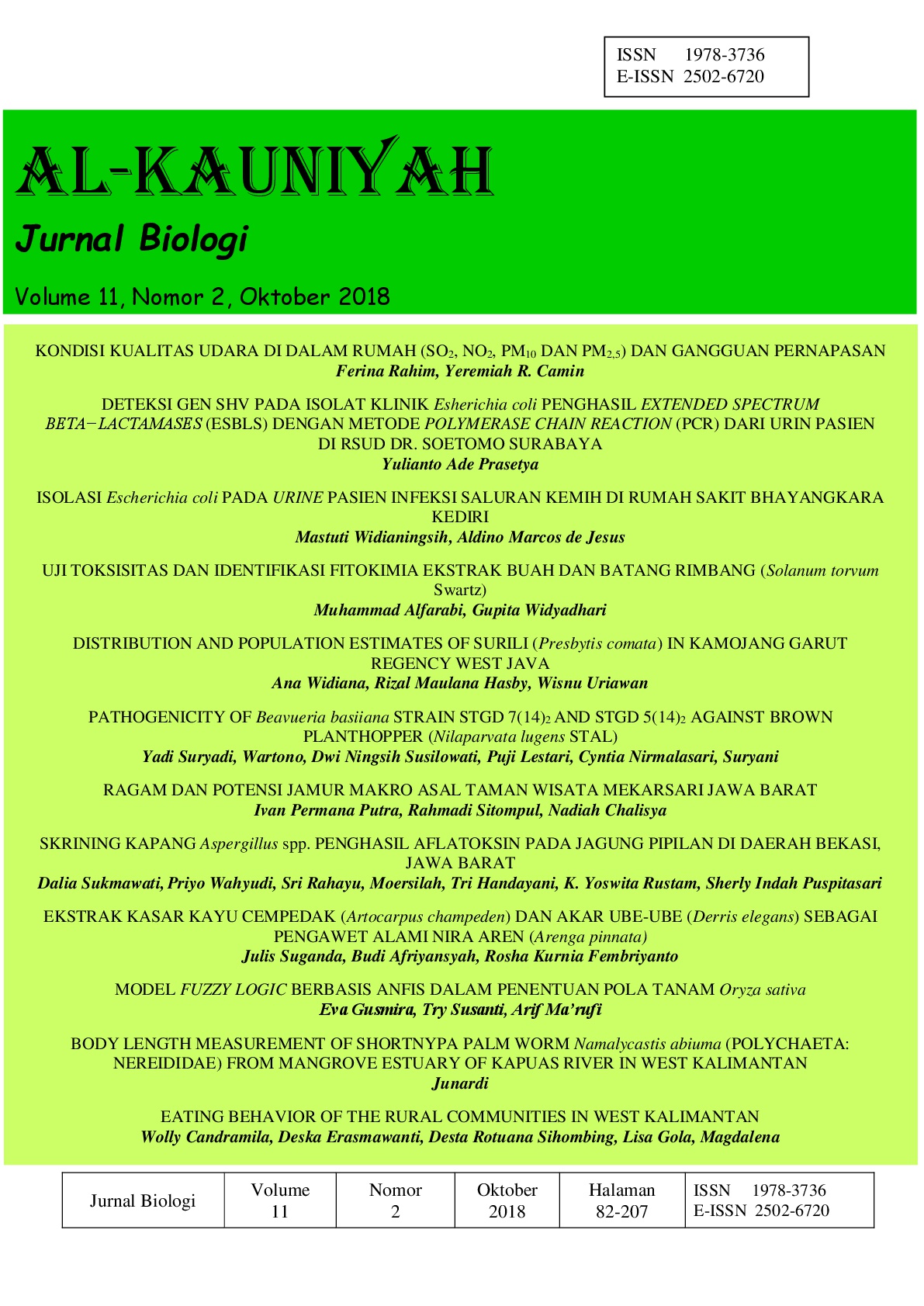UJI TOKSISITAS DAN IDENTIFIKASI FITOKIMIA EKSTRAK BUAH DAN BATANG RIMBANG (Solanum torvum Swartz)
DOI:
https://doi.org/10.15408/kauniyah.v11i2.6360Keywords:
Fitokimia, Rimbang, Solanum torvum, Toksisitas, Phytochemical, ToxicityAbstract
Abstrak
Indonesia memiliki banyak tumbuhan yang dapat digunakan sebagai sumber pangan dan obat, salah satunya adalah rimbang (Solanum torvum Swartz). Rimbang telah dikenal luas sebagai sayuran yang buahnya dapat dimakan secara mentah dan dapat digunakan dalam pengobatan tradisional. Namun demikian, tidak banyak kajian ilmiah mengenai efek toksik beserta senyawa yang terkandung pada buah dan batang rimbang, sehingga tujuan dari penelitian ini adalah memberikan informasi efek toksisitas dari ekstrak buah dan batang rimbang serta senyawa yang terkandung di dalamnya. Metode yang digunakan untuk menguji toksisitas adalah Brine Shrimp Lethality Test (BSLT) dan deteksi senyawa menggunakan uji fitokimia. Hasil penelitian menunjukkan bahwa ekstrak buah dan batang rimbang memiliki efek toksisitas. Nilai LC50 ekstrak buah rimbang sebesar 248 ppm, sedangkan nilai LC50 ekstrak batang rimbang sebesar 129 ppm. Ekstrak buah rimbang mengandung senyawa alkaloid dan tanin, sedangkan hasil uji fitokimia terhadap batang rimbang mengandung alkaloid, saponin, dan tanin. Kedua ekstrak tersebut memiliki potensi untuk dikembangkan menjadi salah satu sumber fitofarmaka antikanker.
Abstract
Many plants in Indonesia are used as food and medicine, such as rimbang (Solanum torvum Swartz). This plant has been widely known as a vegetable which the fruit consumed in raw and also useful in traditional medicine. However, scientific studies on the toxic effects and compounds contained in its fruit and stem have not been widely carried out, so the aim of this study is to provide information on the toxicity effects of them and their compounds. The Brine Shrimp Lethality Test (BSLT) was used to determine the toxicity effect of the extracts, while the compounds in these extracts were detected by using phytochemical assay. The results showed that those extracts have toxicity effects. The LC50 of the fruit extract was 248 ppm while the stem extract was 129 ppm. The fruit extract contained alkaloid and tannin, while the stem extract contained alkaloid, saponin, and tannin. Both extracts have potential to be a resource of anticancer phytopharmaca.
References
Ahmadinejad, F., Møller, S. G., Chaleshtori, M. H., Bidkhori G., & Jami, M. S. (2017). Molecular mechanisms behind free radical scavengers function against oxidative stress. Antioxidants, 6(3), 1-15.
Alfarabi, M., Rosmalawati, S., Bintang, M., Miftahudin, Rofa’ani, E., & Chaidir. (2015). Antiproliferationactivity of tuber protein Typhonium flagelliforme (Lodd.) blume on MCF-7 cell line. International Journal of Biosciences, 6(12), 52-60.
Alfarabi, M., & Fauziayuningtias, A. (2017). Analisis nilai toksisitas ekstrak biji pepaya (Carica papaya) dengan metode Brine Shrimp Lethality Test (BSLT). Natural Science: Journal of Science and Technology, 6(2), 153-158.
Arthan, D., Svasti, J., Kittakoop, P., Pittayakhachonwut, D., Tanticharoen, M., & Thebtaranonth, Y. (2002). Antiviral isoflavonoid sulfate and steroidal glycosides from the fruits of Solanum torvum. Phytochemistry, 59(4), 459-463.
Gurung, P., & De, P. (2017). Spectrum of biological properties of cinchona alkaloids: a brief review. Journal of Pharmacognosy and Phytochemistry, 6(4), 162-166.
Harborne, J. B. (1987). Metode fitokimia: penuntun cara modern menganalisis tumbuhan edisi II. Diterjemahkan oleh Padmawinata K dan Sudiro I. Bandung: ITB Press.
Heldt, H. W. (2011). Plant biochemistry 4th edition. Oxford: Elsevier.
Julfitriyani, Runtuwene, M. R., & Wewengkang, D. (2016). Uji aktivitas antioksidan dan toksisitas ekstrak etanol daun foki sabarati (Solanum torvum). Jurnal Ilmiah Pharmacon, 5(3), 94-101.
Lambers, H., Chapin, F. S. III., & Pons, T. L. (2008). Mineral nutrition. In H. Lambers, F. S. Chapin III, & T. L. Pons (Eds), Plant physiological ecology 2nd ed (pp 255-310). Cheddar, UK: Springer.
Loganayaki, N., Siddhuraju, P., & Manian, S. (2010). Antioxidant activity of two traditional indian vegetables: Solanum nigrum L. and Solanum torvum L. Food Science and Biotechnology, 19(1), 121-127.
Meyer, B. N., Ferrigni, N. R., Putnam, J. E., Jacobsen, L. B., Nichols, D. E., & McLaughlin, J. L. (1982). Brine shrimp: a convenient general bioassay for active plant constituents. Journal of Medicinal Plant Research, 45(5), 31-34.
Naz, R., Ayub, H., Nawaz, S., Islam, Z. U., Yasmin, T., et al. (2017). Antimicrobial activity, toxicity and anti-inflammatory potential of methanolic extracts of four ethnomedicinal plant species from Punjab, Pakistan. BMC Complementary and Alternative Medicine, 17(1), 1-13.
Silva, T. M. S., Nascimento, R. J. B., Batista, M. M., Agra, M. F., & Camara, C. A. (2007). Brine shrimp bioassay of some species of Solanum from Northestern Brazil. Brazilian Journal of Pharmacognosy, 17(1), 35-38.
Sirait, N. (2009). Terong cepoka (Solanum torvum) herba yang berkhasiat sebagai obat. Warta Penelitian dan Pengembangan Tanaman Industri, 15(3), 10-12.
Taiz, L., & Zeiger, E. (2002). Plant physiology 3rd edition. Oxford: Sinauer Associates.
Yousaf, Z., Wang, Y., & Baydoun, E. (2013). Phytochemistry and pharmacological studies on Solanum torvum Swartz. Journal of Applied Pharmaceutical Science, 3(4), 152-160.

